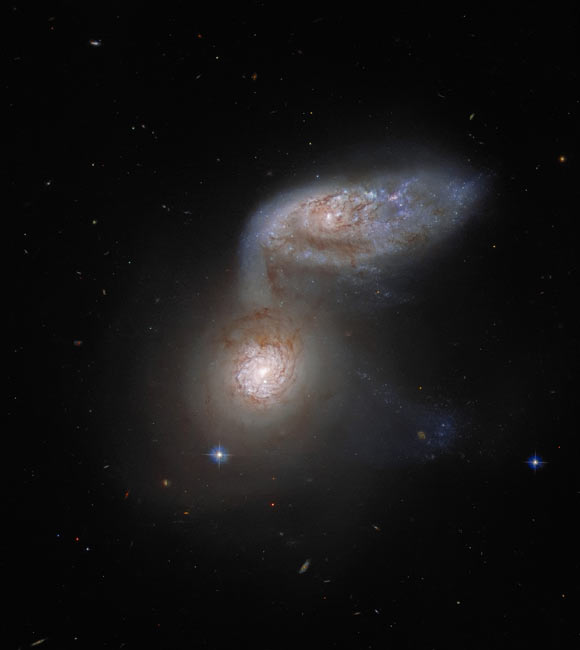The new image, which combines data from the NASA/ESA Hubble Space Telescope, the Victor M. Blanco 4-m Telescope and the Sloan Digital Sky Survey, captures an ongoing cosmic collision between two spiral galaxies in the Arp 91 system.

This composite image shows the interacting galaxy system Arp 91. The color image is made up of observations from Hubble’s Advanced Camera for Surveys (ACS), the Dark Energy Camera (DECam) on the Victor M. Blanco 4-m Telescope and the Sloan Digital Sky Survey (SDSS) in the optical part of the spectrum. Seven filters were used to sample various wavelengths. The color results from assigning different hues to each monochromatic image associated with an individual filter. Image credit: NASA / ESA / Hubble / J. Dalcanton / J. Schmidt.
Arp 91 is located approximately 113 million light-years away in the constellation of Serpens.
Otherwise known as KPG 468, the system was discovered on April 17, 1784 by the German-born British astronomer William Herschel.
“The two galaxies comprising Arp 91 do have their own names,” Hubble astronomers said.
“The lower galaxy, which in this image looks like a bright spot, is known as NGC 5953; and the ovoid galaxy to the upper right is NGC 5954.”
“In reality, both of these galaxies are spiral galaxies, but their shapes appear very different because they are orientated differently with respect to Earth.”
The Arp 91 system is a particularly vivid example of galactic interaction.
“NGC 5954 is clearly being tugged towards NGC 5953 — it looks like it is extending one spiral arm downwards,” the researchers explained.
“It is the immense gravitational attraction of the two galaxies that is causing them to interact.”
“Such gravitational interactions between galaxies are common, and are an important part of galactic evolution.”
“Most astronomers nowadays believe that collisions between spiral galaxies lead to the formation of another type of galaxy, known as elliptical galaxies,” they said.
“These immensely energetic and massive collisions, however, happen on timescales that dwarf a human lifetime — they take place over hundreds of millions of years.”







